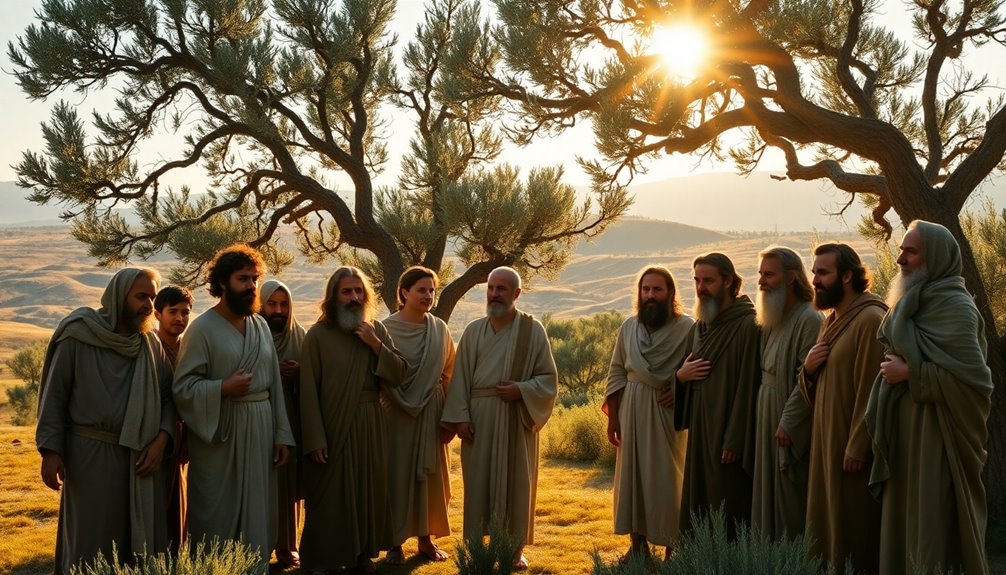The disciples were likely between 13 and 30 years old during Jesus' ministry, reflecting the cultural norms of first-century Jewish society. Most were probably unmarried and might have started their discipleship as adolescents, around ages 13 to 15. For instance, John is estimated to have been 15 to 18, while Peter may have been in his mid-20s. Their youthful energy fostered a dynamic ministry, allowing them to fully commit to Jesus' teachings. You'll find it fascinating how their ages influenced their actions and the early Christian movement, showcasing a powerful impact on their ministry and leadership roles.
Key Takeaways
- Disciples were likely aged between 13 and 30 during Jesus' ministry, reflecting first-century Jewish cultural norms of maturity.
- Peter, possibly in his mid-20s, indicates that some disciples were older, while John was likely 15-18 years old.
- Most Jewish males married by age 18, suggesting many disciples were unmarried and possibly under 20 during their time with Jesus.
- Jesus referred to his followers as "little children," emphasizing their youthful nature and openness to new teachings.
- The youthful ages of the disciples fostered enthusiasm and flexibility, enhancing their commitment to spreading Jesus' message.
Introduction

When you think about the disciples of Jesus, their ages mightn't be the first thing that comes to mind, but it's an intriguing aspect of their story. Most scholars suggest that the disciples were likely between the ages of 13 and 30 during Jesus' ministry, reflecting the cultural norms of first-century Jewish society. This age range not only signifies their youth but also highlights the unique dynamics of their calling.
Jesus often referred to His disciples as "little children," indicating a notable age difference and emphasizing their youthful nature. Many of them were unmarried and free from family obligations, suggesting they were under 20 years old when Jesus called them. This aligns with the Jewish educational system, which typically saw formal studies conclude around age 15.
Peter, being married, implies he was at least in his mid-teens, while John is estimated to be the youngest disciple, possibly around 15 years old.
Understanding the ages of these young men provides valuable insight into the challenges they faced and the remarkable journey they embarked on as the foundational figures of Christianity.
Biblical Age References

When you look at the primary and secondary Bible references, you'll see hints about the ages of Jesus' disciples.
For instance, the term "little children" suggests they were quite young, while the temple tax rules indicate many of them were likely under 20.
These insights help paint a clearer picture of their youth during Jesus' ministry.
Primary Bible References
Biblical age references provide valuable insights into the likely ages of Jesus' disciples. In John 13:33 and John 21:5, Jesus refers to His disciples as "little children," suggesting a significant age difference and indicating their youthfulness. This terminology hints that many of the disciples were quite young.
The temple tax mentioned in Matthew 17:24-27 reinforces this idea, as it was only required from Jewish men aged 20 and older, implying that most disciples were likely under that age.
Cultural practices of the time reveal that young men typically began following a rabbi around ages 13 to 15, aligning with the ages of many of Jesus' disciples. While Peter, as indicated in Matthew 8:14, was likely in his mid-teens or older due to being married, the other disciples were probably younger and unmarried.
The Gospel of Mark (3:16-19) lists the twelve disciples and their behaviors suggest varying ages, with John likely being the youngest at around 15 to 18 years old.
These primary references collectively paint a picture of a group of disciples who were predominantly young, eager learners following their rabbi, Jesus.
Secondary Bible References
Exploring secondary Bible references enriches our understanding of the ages of Jesus' disciples. In John 13:33, Jesus calls His disciples "little children," hinting at their youthfulness. This term suggests a notable age gap between Him and His followers, reinforcing the idea that they were quite young.
Additionally, the temple tax, as outlined in Exodus 30:14-15, required only males aged 20 and older to pay. This implies that the majority of the disciples were likely under that age during Jesus' ministry.
Signs of immaturity also appear in Mark 4:35-41, where the disciples show fear during a storm, further pointing to their youthful status. In the context of Jewish culture, boys celebrated their Bar Mitzvah at age 13, marking the beginning of their religious training and maturity. This aligns with the notion that discipleship often started around this age.
While Peter is known to be married, suggesting he was at least in his mid-teens, the other disciples were likely younger and unmarried. These secondary references provide a clearer picture of the disciples' ages and their early stages of life during their time with Jesus.
Jewish Age of Maturity

In Jewish culture, reaching maturity is marked by significant educational and religious milestones. Boys begin their education at age 5, diving into Scripture, then advancing to the Mishnah by age 10 and the Talmud around age 15. The bar mitzvah ceremony at age 13 is a pivotal moment, signifying a boy's coming of age and his new religious responsibilities. This transition into adulthood is essential as it aligns with the expectations of young men during that time.
Most Jewish males typically married by age 18, but many disciples were likely younger and unmarried while following Jesus. Between ages 13 and 15, young men often sought further religious training under a rabbi, which correlates with the ages of the disciples when they began their journey with Christ.
Discipleship often commenced in adolescence, highlighting that many of the disciples likely joined Jesus in their teens.
Understanding the Jewish age of maturity provides context for the disciples' formative years. Their educational background and early religious experiences shaped their commitment and readiness to engage in the ministry alongside Jesus.
Disciples' Age Impacts Ministry Dynamics

The youthful ages of the disciples, likely ranging from 13 to 30, significantly shaped the dynamics of their ministry with Jesus. Because these disciples were young, they'd the flexibility and enthusiasm to embrace radical changes in their lives. Without the heavy family responsibilities that older individuals often carry, they could travel extensively and dedicate themselves fully to Jesus' mission. This lack of domestic constraints allowed for deeper engagement in the transformative teachings and challenges Jesus presented.
As young Jewish men, they were likely more open to new ideas, which contributed to the dynamic nature of early Christian teachings. Their willingness to embrace the unfamiliar meant they'd follow Jesus through various trials and tribulations, fostering a sense of camaraderie among them. This shared experience made their ministry relatable, especially to younger audiences of the time.
Moreover, their age influenced how they interacted with Jesus and conveyed messages to others, often being viewed as "little children." This perception shaped their approach, allowing them to connect with people in a way that older ministers mightn't have.
Ultimately, their youthful exuberance and openness were crucial in establishing the foundations of their ministry.
Disciples' Ages and Leadership Roles

You might be surprised to learn that the disciples were mostly young, challenging the common belief that only older individuals can hold leadership roles.
In first-century Judaism, cultural norms supported the idea that discipleship began in the teenage years, which shaped the dynamics of their leadership.
Understanding their ages helps debunk misconceptions about youth and authority in the early Christian community.
Debunk Common Age Misconceptions
Misunderstandings about the ages of Jesus' disciples often lead to distorted views of their leadership roles and experiences. Many people picture the disciples of Jesus as old men, seasoned in wisdom and experience. However, historical evidence suggests they were likely between the ages of 13 and 30 during Jesus' public ministry, with most being teenagers or young adults.
Jesus even referred to them as "little children" in John 13:33 and John 21:5, emphasizing their youthful status and potential lack of life experience.
Moreover, the temple tax, which applied only to Jewish men aged 20 and older, reinforces this idea. Since only Peter and Jesus paid the tax, it implies that most disciples were under this age. Cultural norms of the time indicate that young Jewish males typically began their discipleship around ages 13 to 15. This suggests that many disciples were still in their adolescence when they followed Jesus.
For example, John was likely the youngest, estimated to be around 15-18 years old. In contrast, Peter, being married, suggests he was at least in his mid-20s.
Understanding their true ages helps clarify their leadership dynamics.
Cultural Norms Around Age
In first-century Jewish society, age played a crucial role in shaping a young man's path to religious life and leadership. Jewish boys typically began their religious education at age 5 and were expected to seek a rabbi for discipleship around ages 13 to 15. This aligns with the ages of Jesus' disciples, suggesting they were at a pivotal point in their spiritual journey.
The Bar Mitzvah ceremony at age 13 marked their transition to adulthood, indicating many disciples were of an age where they were expected to take on significant religious responsibilities.
Cultural norms allowed young men to leave their familial obligations to follow a rabbi, demonstrating a commitment that belied their youth. Most Jewish males married by age 18, implying the apostles were likely unmarried and younger.
The temple tax law required payment from men aged 20 and older, suggesting that most of Jesus' disciples were under this age. This environment fostered a unique leadership dynamic where older men guided younger ones, allowing those in their teens to embrace significant roles in the early Christian movement, despite their youth and inexperience.
Youthful Zeal in Ministry

When you think about the youthful ages of the disciples, it's clear their energy fueled their ministry.
This enthusiasm not only drove them to spread Jesus' teachings but also set an example for engaging young leaders today.
Embracing that same zeal can ignite a passion for service in your own community.
Embrace Youthful Enthusiasm in Service
While youthful enthusiasm may sometimes be overlooked in ministry, it's a powerful force that can drive impactful service. Just look at the disciples, who were likely between 13 and 30 years old. Their youthful energy allowed them to embrace the demanding ministry alongside Jesus with zeal.
This enthusiasm fueled their commitment to spreading the Gospel, as they bravely traveled, preached, and healed, even in the face of danger.
Young people often possess qualities like impulsiveness and a thirst for adventure, which the disciples exemplified in their bold actions.
In first-century Judaism, young men stepped into roles of responsibility early, enabling them to take significant risks without the burden of family obligations. This cultural context empowered the disciples to dive headfirst into their mission.
Engage Young Leaders Actively
Youthful leaders hold the key to revitalizing ministry with their fresh perspectives and boundless energy. Just look at Jesus' disciples, who were likely between 13 and 30 years old. Their age didn't limit their impact; instead, it allowed them to bring innovative ideas and enthusiasm to early Christian teachings.
Engaging young leaders in your church recognizes their potential and emphasizes the importance of nurturing that youthful zeal.
In first-century Judaism, young men sought rabbinic mentorship around ages 13-15, highlighting the value of engaging youth in leadership roles today. By encouraging young individuals to step into active positions, you foster a sense of responsibility and commitment similar to the sacrifices made by the apostles.
It's crucial to challenge misconceptions about age and capability in ministry.
When you empower young leaders, you're not just shaping the future; you're also enriching current ministry initiatives and outreach efforts. By recognizing the significant contributions of youth in scripture, your faith community can harness their energy and creativity.
Moreover, understanding the emotional dysregulation often experienced by young leaders can enhance mentorship strategies and support systems.
Engage them actively and watch as they transform your ministry with their unique insights and passion.
Youthful Discipleship's Lasting Impact

The youthful ages of the disciples had a profound impact on their ministry and the future of Christianity. Ranging from 13 to 30, their youthfulness allowed them to engage actively in discipleship, traveling and spreading Jesus' teachings without the burdens of family responsibilities. This flexibility not only facilitated their ministry but also highlighted their role as learners, as Jesus often addressed them as "little children," emphasizing the age difference and their need for guidance.
The sacrifices made by these young apostles—leaving careers and societal expectations—demonstrated their deep commitment to spiritual pursuits over worldly ambitions. Their boldness in following Jesus serves as an inspiration, encouraging future generations to prioritize faith and leadership.
By recognizing the youthful nature of the disciples, you can appreciate the courage required for their sacrifices and the remarkable impact they'd on Christianity.
Today, this legacy invites a reevaluation of the potential of young people in spiritual leadership. The disciples' youthful discipleship reminds you that significant change can arise from those willing to embrace their faith wholeheartedly, challenging you to nurture and empower the next generation of leaders.
Additional Resources

Recognizing the youthful ages of Jesus' disciples opens up a wealth of resources for further exploration. You might want to delve into historical texts and biblical commentaries that discuss the cultural context of first-century Judaism, which can provide insights into why Jesus chose such young disciples.
Look for discussions around the training boys underwent, beginning as early as age five, and how they sought out a rabbi for discipleship between ages 13 and 15.
Additionally, exploring theological analyses can shed light on how Jesus' references to his followers as "little children" indicate the significant age difference between him and his disciples. This dynamic can deepen your understanding of their relationships and the impact of youth on their ministry.
You can also find resources that examine the implications of the disciples' marital statuses, noting that most were likely unmarried and young, which can add layers to your comprehension of their commitment to Jesus and his teachings.
Lastly, consider looking into scholarly works that explore the ages of specific disciples, like John, possibly the youngest at 15, and Peter, likely the oldest, at around 30.
Frequently Asked Questions
What Were the Ages of the 12 Apostles?
The ages of the 12 apostles during their time with Jesus likely varied significantly.
You'd find most of them were between 13 and 30 years old, adhering to cultural norms.
John, often seen as the youngest, might've been around 15 to 18, while Peter, probably the oldest, could've been 26 to 30.
This youthfulness reflects their roles as disciples, with many being unmarried and referred to as "little children" by Jesus.
Who Was the Youngest of the 12 Disciples?
The youngest of the 12 disciples is commonly believed to be John.
You might find it interesting that he was likely around 15 to 18 years old during Jesus' ministry. His close relationship with Jesus, often referred to in the Gospel of John as "the disciple whom Jesus loved," highlights this youth.
This age difference is further reinforced by Jesus' references to the disciples as "little children," indicating their significant youth compared to Him.
Were the 12 Disciples Teenagers?
Yes, the 12 disciples were likely teenagers or young adults during Jesus' ministry. Most scholars suggest their ages ranged from 13 to 30, with many being in their teens.
For instance, John might've been around 15 years old when he began following Jesus. This youthful group reflects the cultural norm of young men seeking a rabbi for discipleship, emphasizing their relative youth compared to Jesus, who was around 30 at the time.
How Old Were the 12 Disciples Catholic?
When considering how old the 12 disciples were, you'll find they were likely quite young.
Most scholars suggest they were teenagers or young adults during Jesus' ministry. John, the youngest, may have been around 15, while Peter could have been in his mid-20s to 30s.
Given the cultural norms of the time, it's reasonable to think many were unmarried and under 20, highlighting their youthfulness in following Jesus.










